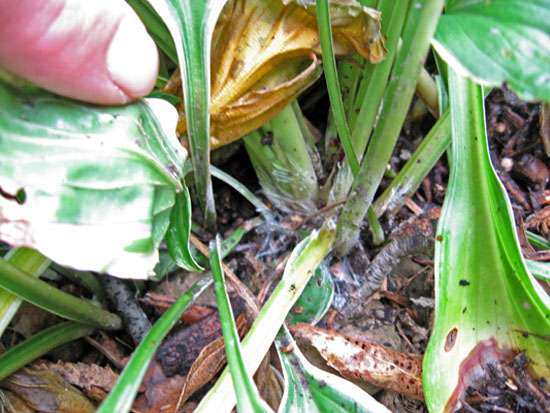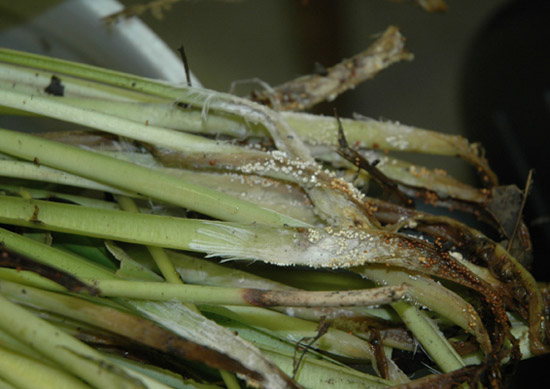Issue 13, July 30, 2010
Hosta Petiole Blight
This past week we had a beautiful case of hosta petiole blight. I beg the pardon of the grower whose hosta was devastated by this disease. It is truly amazing that a fungal pathogen can so totally take over a large, otherwise healthy, hosta, causing all of its leaves to collapse.
Sclerotium blight, also known as Southern Blight, is caused by a fungus, Sclerotium rolfsii. For many years it was thought of as a southern disease because it was not known to survive typical Midwest winter (low) temperatures. The popular practice of mulching plants, especially over the winter, has helped protect this fungus through otherwise killing low temperatures. In fact, research at Iowa State University has shown that the pathogen can survive under mulched hostas, but the fungus is often killed when mulch covering is removed before winter.
Symptoms begin in hot, humid weather with wilting and discoloration of lower leaves. In a short time the upper leaves also wilt; and close inspection shows a soft, brown rot of the base of petioles. The entire leaf collapses above the site of infection. The fungus, Sclerotium rolfsii, appears as a flat, white matt of mycelium on the petioles and surrounding soil. The first image shows this mycelium on an infected hosta in Urbana this past week (photo courtesy of Travis Cleveland). This is often referred to as a fan of mycelium. Tiny tan, mustard seed-sized sclerotia (fungal survival structures) can be seen in this mycelium and on the soil as shown in the second image. The pathogen has invaded our state, probably from the south, and probably as sclerotia on transplants. Hosta is only one of many hosts of this fungus.


How do we manage this disease on hosta? The fungus is spread by sclerotia or by mycelium growing from the sclerotia. There are no spores. Remove all of the infected plant parts, placing them directly into a bag to remove them from the garden. Also remove the top several inches of soil around the plant, again being careful not to spill any as you work. If you dig up the entire plant, turn the soil over to help sclerotia decompose more quickly. If you plan to work with the plants you have, there are couple of fungicides that may have some suppressive characteristics and are registered for use on ornamentals. Flutolanil and PCNB are available for commercial application. There is nothing guaranteed to control this pathogen. Some homeowners have tried thiophanate-methyl, which also has a general ornamental label. Pull mulch back from the base of plants before winter to help kill the fungus. There are differences in levels of susceptibility among hosta cultivars, but nothing with high levels of resistance. Iowa State University has a very good publication on Sclerotium Blight (Adobe PDF).--Nancy Pataky
Author:
Nancy Pataky